《画家王田》
- 2020-11-23 16:06:19
- 点赞量:6219
- 点击量:110229
- 作者:郝连成 Hao Liancheng
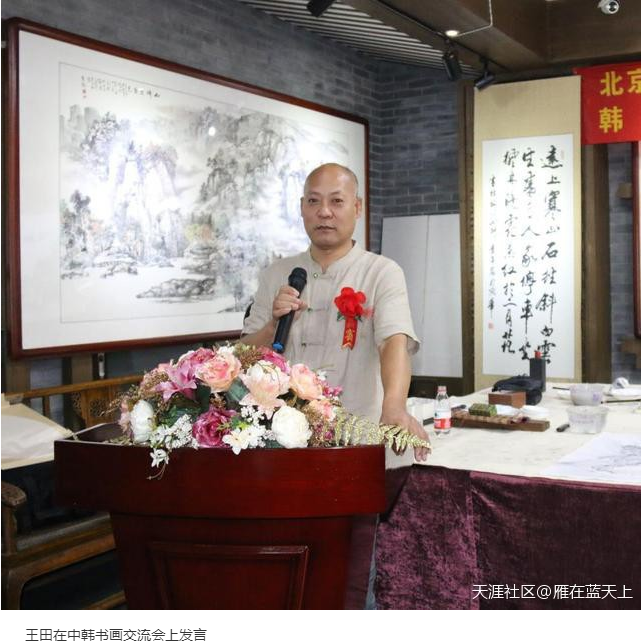
入夏以来,一个叫王田的国画家突然在网络上火了起来,先是在宣和书画艺术研究院的固安基地进行写生访问。又应李可染画院邀请,在李可染画院美术馆,参加“江山如画——李可染师生作品展”开幕式。后又参加中韩文化交流笔会活动,代表中方书画家与韩国泰东书院的书画家进行了现场作画并发表了学术演讲。王田用国画技法与陶瓷绘画技法的结合笔法令韩国画师赞叹不已。说:历史上中国画就一直领先亚洲乃至世界。现在王田老师又创出了新派画法,让人感到震惊,中国的艺术家有让人永远学不完的东西。
Since the beginning of summer, Wang Tian, a Chinese painter, suddenly became popular on the Internet. He first visited Gu'an base of Xuanhe calligraphy and painting art research institute. At the invitation of Li Keran painting academy, he participated in the opening ceremony of "picturesque landscape - works exhibition of Li Keran's teachers and students" in the art gallery of Li Keran Painting Academy. After that, he took part in the pen meeting for cultural exchange between China and South Korea. On behalf of Chinese Calligraphers and painters from Taitung Academy in South Korea, they made live paintings and delivered academic speeches. Wang Tian used the combination of traditional Chinese painting techniques and ceramic painting techniques to make Korean painters marvel. Chinese painting has always been ahead of Asia and even the world in history. Now Mr. Wang Tian has created a new style of painting, which makes people feel shocked. Chinese artists have something to learn forever.
王田,1963年生于河北省唐山,河北省陶瓷艺术大师,河北省工艺美术家协会会员。师从国画大师冯霖章先生。通过潜心学习,深得冯霖章大师的器重。作品立意清新自然、格调高雅;画面细腻生动、妙境天成;意境超凡脱俗、如诗如画。其绘画题材以花鸟、山水为主,工笔和写意装饰技法结合的特别鲜明,尤以综合表现工笔花鸟和写意山水融合之美见长。作品既凸显工笔的细腻逼真之功力,又充分表达出写意的飘逸洒脱之韵味。
Wang Tian, born in 1963 in Tangshan, Hebei Province, is a master of ceramic art and a member of Hebei Arts and Crafts Association. He studied under the master of Chinese painting, Mr. Feng Linzhang. By studying with great concentration, he won the respect of master Feng Linzhang. The works are fresh and natural, elegant in style, delicate and vivid in pictures, natural in Wonderland and extraordinary in artistic conception. His paintings are mainly about flowers and birds, landscapes, and the combination of Meticulous Brushwork and freehand brushwork decoration techniques is particularly distinctive, especially in the comprehensive performance of fine brushwork flowers and birds and freehand brushwork landscape fusion. The work not only highlights the delicate and realistic skill of Meticulous Brushwork, but also fully expresses the elegant and free charm of freehand brushwork.
现在就职于中国瓷都景德镇的王田,在中国陶瓷领域早已闻名,作品《花开依稀春水香》《 花影疏斜水清浅》《花路入溪口》《花明涧谷幽》《溪山清韵》等作品,分别获得江西国防陶瓷艺术大赛金奖,奥林匹克陶瓷艺术节银奖。《汪辜会谈》瓷盘像被央视报导。亚州最大陶瓷对瓶的画作《秋韵》就出自王田的手笔。
Wang Tian, who works in Jingdezhen, China's porcelain capital, has long been well-known in the field of Chinese ceramics. His works, such as the fragrance of spring water when flowers bloom, the shadow of flowers and the light water, the entrance of flower road into the creek, the quiet valley of huamingjian, and the Qingyun of Xishan, have won the gold medal of Jiangxi national defense ceramic art competition and the silver award of Olympic Ceramic Art Festival. "Wang Gu talks" porcelain plate image was reported by CCTV. Autumn rhyme, the largest ceramic vase painting in Asia, was written by Wang Tian.
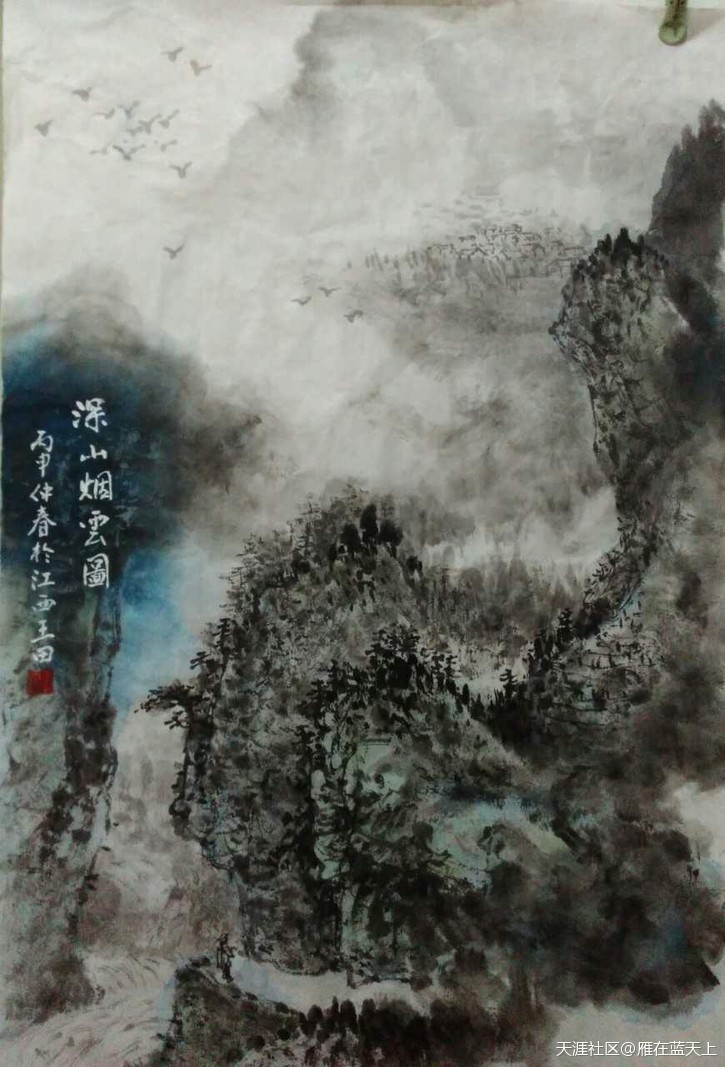
北京市政府,上海市政府,西藏自治区政府均收藏有王田的陶瓷作品。 2015年,江西电视台在《寻找最具潜力的艺术家》栏目中对王田的艺术成就进行了专题报道,使王田的名气大增。此次代表中国艺术家与韩国艺术家交流果然表现不俗,让韩国同行对中国的绘画艺术有了新的认识。
The Beijing municipal government, the Shanghai municipal government and the Tibet Autonomous Region government have collected Wang Tian's ceramic works. In 2015, Jiangxi TV station made a special report on Wang Tian's artistic achievements in the column "looking for the most potential artists", which greatly increased Wang Tian's fame. On behalf of Chinese artists and Korean Artists Exchange, the performance is really good, let the Korean counterparts have a new understanding of Chinese painting art.
1963年王田出生在河北唐山迁西的一个农村,从小赶上文化大革命,“地利”和“天时”使他失去了认真读书的机会。但并没有湮没小王田对绘画的兴趣。
Wang Tian was born in 1963 in a rural area of Qianxi, Tangshan, Hebei Province. He caught up with the Cultural Revolution when he was young. Because of the geographical advantages and the favorable weather, he lost the opportunity to study seriously. But it did not annihilate his interest in painting.
“从小我就喜欢画画,画鸡画鸭,画树画花,画山画水,那时临摹《铁道游击队》连环画。逮啥画啥,老师和同学都说我画啥像啥”。
"Since I was a child, I like painting chickens, ducks, trees, flowers, mountains and water. At that time, I copied the comic book" railway guerrillas ". The teacher and classmates all say that what I draw looks like.
王田用淳朴的语言向记者讲述他的学画经历。从王田的讲述中可以了解到,他是靠自己的勤奋和天赋而自学成才。
Wang Tian used simple language to tell reporters about his painting experience. From Wang Tian's narration, we can know that he was self-taught by his own diligence and talent.
18岁那年,王田因会画画被招进了唐山陶瓷厂,从此做了陶瓷术艺画师。此期间有幸被中国美术家协会会员、国家高级美术师、唐山书画院院长和一多书画苑理事长冯霖章先生收为学生。从此王田在绘画的途中走上了一条传承和创新之路。
At the age of 18, Wang Tian was recruited to Tangshan Ceramic Factory because he could draw. He became a ceramic art painter since then. During this period, he was admitted as a student by Feng Linzhang, member of China Artists Association, national senior artist, President of Tangshan Academy of calligraphy and painting, and chairman of more than one calligraphy and painting garden. From then on, Wang Tian embarked on a road of inheritance and innovation.
在冯霖章老师那里,通过观摩冯霖章作品和对绘画理念的讲解,王田系统学习和研究了中国画的传统技法。他总结冯霖章作画的特点是: 首先他把工艺绘画与泼墨泼彩所造成的幻化效果巧妙的结合起来。这种自然幻化的肌理效果与精工细琢的绘画互相渗透,混成一体,产生了极鲜明的特色,兼具有颇高的难度。要掌握这种有机的结合,必须有扎实的传统绘画基本功以及对泼墨泼彩所产生只幻化特性有长期深入的研究,同时也要对生活有深刻的体会和具有想象力。
Wang Tian systematically studied and studied the traditional techniques of Chinese painting by observing his works and explaining his painting ideas. He summed up the characteristics of Feng Linzhang's painting: first of all, he skillfully combined the craft painting with the illusory effect caused by splashing ink and color. This kind of natural and illusory texture effect and meticulous painting permeate and blend into a whole, which produces a very distinctive feature and has a high degree of difficulty. In order to master this organic combination, we must have solid basic skills of traditional painting and have a long-term and in-depth study on the illusory characteristics produced by splashing ink and color. At the same time, we should have a deep understanding of life and imagination.

其次,在色彩的运用上,冯霖章明显的吸收了西方绘画对光与色之关系的理解和处理手法,使画面出现了丰富的变化和层次感。同时,他以微观的花鸟和宏观的山水相结合的画法,使画面产生以小见大,大中见小的崭新艺术效果。 他以山花野草、飞瀑流泉、云海苍山等充满大自然气息的内容为主题的作品,都充满着一股浓郁的原汁原味的味道,并能带领人们进入一种既恬静又清新的神话般的境界。这足以反应出他对大自然和生活的热爱,亦是他那不追逐名利之淡薄心境的写照。
Secondly, in the use of color, Feng Linzhang obviously absorbed the understanding and processing techniques of the relationship between light and color in Western painting, making the picture appear rich changes and sense of hierarchy. At the same time, he uses the combination of micro flowers and birds and macro landscape to create a new artistic effect. His works, which are full of natural flavor, such as mountain flowers and wild grass, waterfalls and flowing springs, sea of clouds and Cangshan Mountain, are full of a strong flavor of the original, and can lead people into a quiet and fresh mythical realm. This is enough to reflect his love of nature and life, and also a portrayal of his indifferent mood of not pursuing fame and wealth.
从这些总结中王田知道了自己该从哪里努力向老师看齐。经过多年的揣摩实践,在泼墨泼彩上王田已掌握了冯霖章老师的技法,甚至在有些地方还有所发挥和突破。在陶瓷的色彩处理运用上,王田利用温度的变化使作品的效果更加清新、艳丽而有天然之美。
From these summaries, Wang Tian knew where he should try to keep up with his teacher. After years of speculation and practice, Wang Tian has mastered the skills of Mr. Feng Linzhang in splashing ink and color, and even has played and made breakthroughs in some places. In the application of ceramic color treatment, Wang Tian used the change of temperature to make the effect of his works more fresh, gorgeous and natural.
从冯霖章老师的身上,王田学到最多的还是那种“不逐名利的淡薄心境”的胸怀。随着王田的艺术成就被社会的认可,很多人都说王田该评为国家级艺术大师。王田低调地说:“哪级大师要靠作品说话,不是包包里掏出个证来就是大师了。”
From Feng Linzhang's teacher, Wang Tian learned the most from the mind of "not pursuing fame and wealth". With Wang Tian's artistic achievements recognized by the society, many people say that Wang Tian should be rated as a national art master. Wang Tian said in a low-key way: "which level of master depends on works to speak, it is not a certificate from the bag that is a master."
如今,王田在唐山的老家还有几亩薄田。每年他都要回去耕作几天,他不是为了土里求食,而是名字里就离不开“田”字。
Today, Wang Tian's hometown in Tangshan has a few acres of thin farmland. Every year, he goes back to work for a few days. He doesn't want to eat in the soil, but he can't leave the word "field" in his name.
田让他接了地气,深入了生活,有了创作的源泉。
Tian let him contact with the earth, in-depth life, with the source of creation.
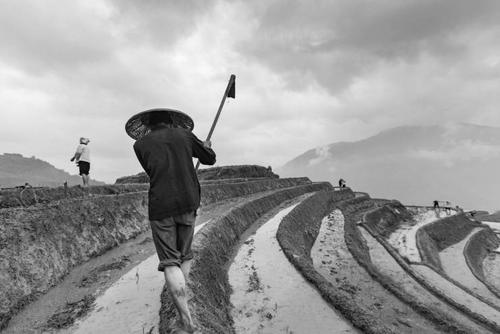
郝连成 2016年8月23日采访于河北固安 完稿于 香河香汐花园
Hao Liancheng interviewed in Gu'an, Hebei Province on August 23, 2016, and finished his manuscript in Xiangxi garden, Xianghe


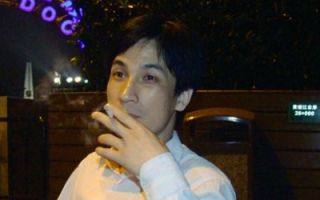
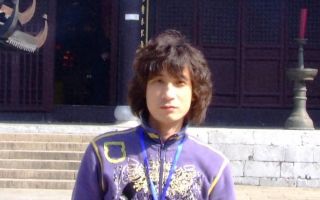
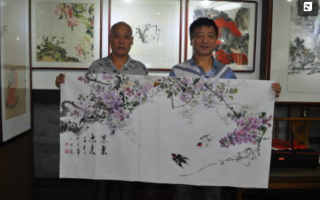
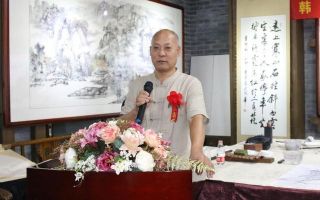
雁在蓝天